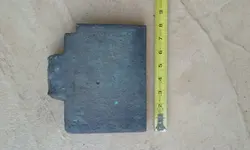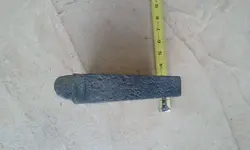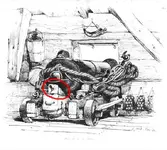This bronze type alloy wedge was found on a wreck in Bahamas dating around 1798 to 1815 or so. Believe it was a French ship. Lots of musket balls, cannon balls. Thought maybe some kind of cannon wedge but usually were wood and never seen one like this. Any ideas?
You are using an out of date browser. It may not display this or other websites correctly.
You should upgrade or use an alternative browser.
You should upgrade or use an alternative browser.
Shipwreck artifact
- Thread starter SteveS
- Start date
- Joined
- Apr 24, 2010
- Messages
- 12,923
- Reaction score
- 27,656
- Golden Thread
- 1
- Location
- Upper Canada 🇨🇦
- 🥇 Banner finds
- 1
- 🏆 Honorable Mentions:
- 3
- Detector(s) used
- XP Deus, Lesche Piranha 35 Shovel & 'Garrett Carrot'
- Primary Interest:
- Relic Hunting
I found this info in Wikipedia... could this be what you found, I think you maybe right? 
"A carronade is a short, smooth bore, cast-iron cannon. In some versions, a wedge was placed underneath the chamber to control elevation, while in later versions an elevating screw was used."
I wonder if 'TheCannonballGuy' might know?
Dave

"A carronade is a short, smooth bore, cast-iron cannon. In some versions, a wedge was placed underneath the chamber to control elevation, while in later versions an elevating screw was used."
I wonder if 'TheCannonballGuy' might know?
Dave
Attachments
Upvote
0
Tony in SC
Gold Member
- Joined
- Jun 8, 2006
- Messages
- 6,411
- Reaction score
- 9,248
- Golden Thread
- 0
- Location
- Upstate South Carolina
- Detector(s) used
- Whites, Minelab, Tesoro, and custom machines
- Primary Interest:
- Metal Detecting
I think Dave has it! Wedges were used on early ship's cannon for elevation. We have a firing model of the one Dave posted.
I found this info in Wikipedia... could this be what you found, I think you maybe right?
"A carronade is a short, smooth bore, cast-iron cannon. In some versions, a wedge was placed underneath the chamber to control elevation, while in later versions an elevating screw was used."
I wonder if 'TheCannonballGuy' might know?
Dave
Upvote
0
- Joined
- Apr 24, 2010
- Messages
- 12,923
- Reaction score
- 27,656
- Golden Thread
- 1
- Location
- Upper Canada 🇨🇦
- 🥇 Banner finds
- 1
- 🏆 Honorable Mentions:
- 3
- Detector(s) used
- XP Deus, Lesche Piranha 35 Shovel & 'Garrett Carrot'
- Primary Interest:
- Relic Hunting
Cannon wedges were usually made of wood. This is quite heavy, and no idea what the notches on it would be for. Think it's for something else, but I've been wrong before.
I'm having trouble seeing the 'notches' you're referring to, are they running down the side of the piece?
If so, these may have been used indicate the angle of trajectory, if this in deed is a cannon wedge?
Dave
Upvote
0
Similar threads
- Replies
- 19
- Views
- 6K
Users who are viewing this thread
Total: 1 (members: 0, guests: 1)






